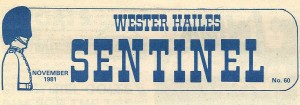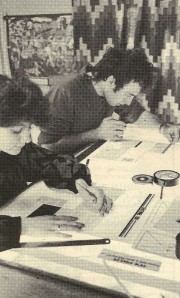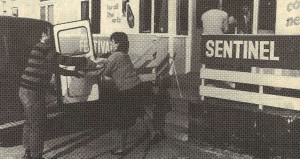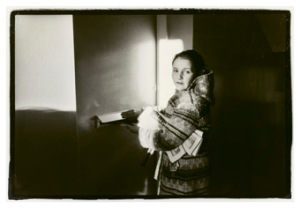As part of the savings being made in the City of Edinburgh Council budget, the remaining printed community newspapers in Edinburgh have had their funding cut. The Evening News featured the imminent demise of the North Edinburgh News before the cuts were announced. The paper survived previous rounds of cuts through the support from its local Neighbourhood Partnerships which chose to award some of their Fairer Scotland funding allocation to the paper. But with the centralisation of this fund from March 2011, the NEN team are prepared for closure and started organising their final issue. This will feel familiar to many residents in Wester Hailes who will remember the West Edinburgh Times having to close their doors two years ago. Other papers facing closure include the Craigmillar Chronicle and the Speaker in Restalrig.
Community newspapers provide positive news stories about areas that often suffer from an unjustified negative image elsewhere in the media world. They link people in to local services and activities by providing detailed information straight through their front doors. And they document life across the years, acting as a local archive. This article looks at the valuable role community newspapers offer and in particular their ability to generate a higher level of local democracy.
The demise of the North Edinburgh News follows a trend that can be seen at a national level. Between January 2008 and August 2009 alone, the Newspaper Society reported that 101 local newspapers closed down. Here in South West Edinburgh, the West Edinburgh Times, which was the successor to the Sentinel, was finally forced to close its doors in 2008 when funding to the Edinburgh Community Newspaper Trust was axed, cutting off financial support both to the West Edinburgh Times and other local community newspapers in Edinburgh.
Last year the Media Trust commissioned research into the value of community newspapers in promoting local democracy. The research showed that people still want local media, particularly printed newspapers. They want truly local reporting and independent journalism that reflects local concerns. The Media Trust believes that the importance of this independence cannot be overstated, arguing that local news should be in the hands of local people. It points out that the production and circulation of independent, quality news is a hallmark of democratic societies. The resulting report, “Meeting the News Needs of Local Communities” demonstrates that many people feel disengaged with the democratic process and disempowered from influencing decisions that affect them and their environment. Community media draws a community together. It articulates the concerns and aspirations of the area and encourages people to become involved in local issues.
“A good local news service in this sense is one that gives a voice to the voiceless; that is prepared to listen to and represent the concerns of ordinary local people; and is willing to act as a fourth estate, holding power to account.” (1)
This ethos lay at the heart of the Sentinel and its reporting. During its history, the paper changed format several times, evolving from being an A4 newsletter to a broadsheet. The front page altered visually as printing technology advanced and the paper’s budget increased.

As different reporters, columnists and cartoonists came and went, the shape of the news and features content changed. But throughout the Sentinel’s existence, there was a clear understanding that the paper was there to represent the people of Wester Hailes and to act as a unified voice for the area. Over the years it campaigned again and again on key local issues with an emphasis on challenging injustices and highlighting the need for change. It also understood the value of positive news reporting, recognising the need to combat the endless treadmill of negative news items about the area being promoted by the larger commercial publications. Whilst Wester Hailes faced many challenges, it also had much to be proud of and the Sentinel made sure this was recognised and publicised.
“We are a community newspaper. But what is community? Community spirit only exists when individuals believe that the good of others is more important than the pursuit of their own self interest.
It is our belief that the purpose of a community newspaper is to build community spirit. The more successful the Sentinel, the stronger is the community spirit of Wester Hailes: the stronger the community spirit of Wester Hailes, the more successful is the Sentinel.”
(Front page editorial Issue 100- 19th March- 15th April 1985)
The Sentinel was founded by Hector McCrae with the first edition being printed in October 1976. From the beginning Hector encouraged local people to contribute articles to the newspaper, believing that the paper should directly reflect the interests of those living in the area rather than the views of one person. This led to a Sentinel group being established to oversee the organising of the paper, formed by representatives from each of the local tenants’ associations. You can read an interview with Hector by clicking here on the Sentinel March 1985. The interview formed part of a special edition to mark the 100th edition of the paper.
The Media Trust report clearly demonstrates that people want local news, and that most people would like more local news rather than less. But there are different definitions as to what constitutes local news and the report differentiates clearly between information services and truly local independent investigative journalism. Those surveyed did not regard the free publications they received from their local council or other public bodies as news. Whilst they provide information, they are not journalism and they are not an independent voice.
“Local people seek reporting from those they know understand what goes on locally, or who are at least willing to learn. This means having a local presence, being seen to ferret out information, dig behind it, and make sense of it. They want analytic depth and scepticism regarding those in power, context, and debate. They want stories that are compelling because they are relevant to them and they want to be part of the conversation”
The Sentinel acted as an independent voice and promoted the use of local stories. For its 100th issue, the Sentinel featured its previous editors discussing some of the highlights and problems they faced during their time there. You can read their views here at Sentinel March 1985 .
The report suggests that an independent local presence is key to building trust in what is being reported. People wanted the news organisation to have a local physical base and for its journalists to be in the actual locality. It is this that gives the readers confidence in the truth, independence and accountability of what is being written. Throughout its life, the Sentinel’s offices remained in the community which it served and the paper emphasised the importance of using local writers and contributors.
The Sentinel reported news but it also scrutinised, questioned and campaigned. When its successor, the West Edinburgh Times finally closed its doors in 2008, local people had less access to information about what was happening in the area. Some steps have been taken to try and improve this situation. But the loss of a community newspaper has meant Wester Hailes has lost an important voice, a way of bringing people together and of acting as a rallying call on issues that need challenging.
The Sentinel balanced its campaigning role with the reporting of local news items, recognising the importance of people’s stories and experiences. Although not shying away from the problems facing people living in Wester Hailes, it also promoted local achievements and good news stories as well as acting as an archive for the events in people’s lives, recording key moments such as weddings and birthdays. Yet it was also able to reflect outwards from the area, connecting Wester Hailes to wider city and national issues, giving people the opportunity of reading the views and aims of a range of regional and national figures, both political and those outside the political arena. The Sentinel may have been a community newspaper produced with limited resources but it was always highly professional both in content and format.
Interestingly, the research carried out for the Media Trust report shows that
despite being in the age of the internet, most people surveyed for the report still wanted a printed newspaper as their way of accessing local news. Although more people now obtain news online, it is not their primary source for information on local events and issues. Of course, this situation may change over time and is partly to do with the current digital divide as we increasingly become a society where a lack of internet access excludes groups of people. But there is something about the definite geographical coverage of a printed newspaper that is delivered to people’s doors that increases the sense of connection people have with their area. And while many people do use the internet and interact with local websites, there is a difference between happening across relevant news items in this way and having them on the front page of a newspaper that has been pushed through your letterbox. A newspaper is easy to leave and go back to and of course it’s portable. And there is also a difference between the volume and level of information provided online and what was laid out across the pages of the Sentinel, particularly in their regular around the neighbourhoods feature. For an example of this click here on September 1987.
The world in which small local community newspapers now have to operate is harsher financially, with escalating printing costs and a decline in interest from advertisers. Yet at a time when local interaction with democracy is decreasing, generating endless debate and reports on what should be done, surely investment in the local community news sector would assist and would represent good value? Undoubtedly there are difficult spending decisions to be made. But allowing these independent community voices to disappear seems to be short term thinking at a time when much effort and resources is being placed into trying to involve more people in local democracy. As the Sentinel showed, community newspapers are the most effective way of achieving this, and they never needed a glossy cover to get people involved!
1) “Meeting the News Needs of Local Communities”; new research by Goldsmiths Leverhulme Media Research Centre commissioned by Media Trust







Pingback: Introducing the Digital Sentinel for Wester Hailes | Digital Sentinel
Pingback: Leaving the Sentinel: 5 things I have learned about faciliatating community-led media | Jennifer M Jones